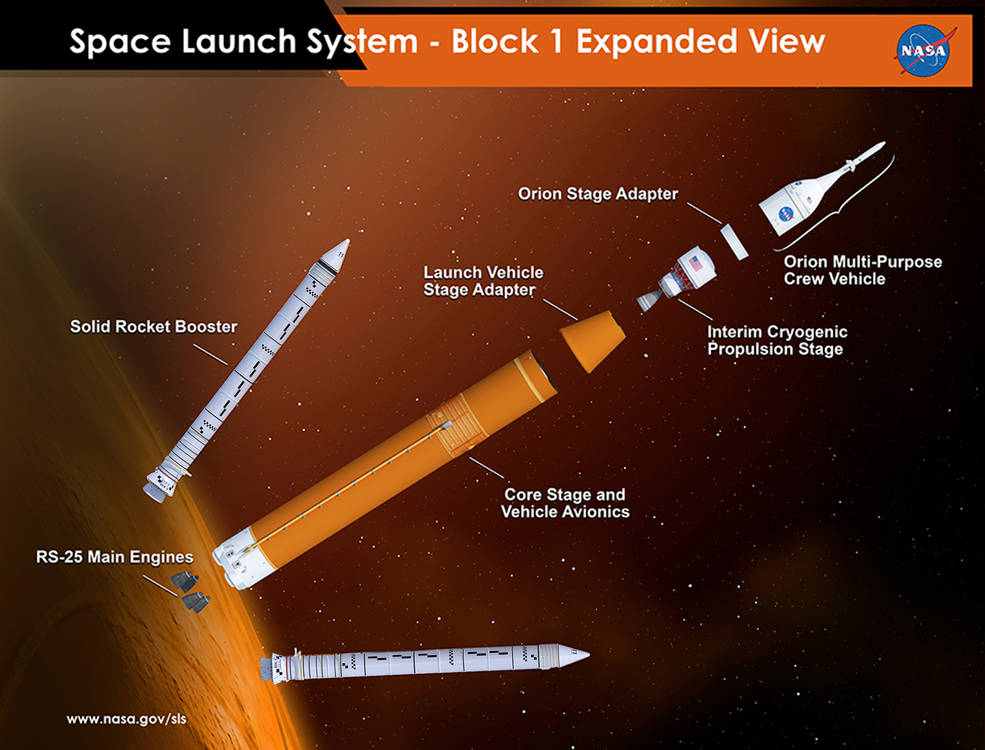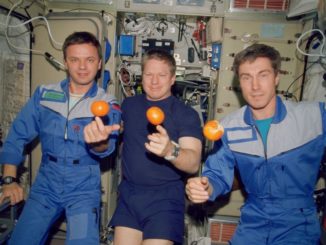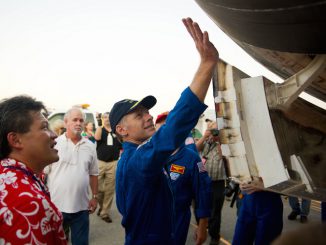
Fueled segments of the solid rocket boosters that will lift off on the first flight of NASA’s Space Launch System have arrived at the Kennedy Space Center in Florida, but officials will hold off on stacking the boosters until the SLS core stage completes a crucial test-firing later this year.
Loaded in 10 specially-designed railcars, the 10 segments that will make up the first Space Launch System’s twin solid rocket boosters rolled into the Kennedy Space Center on June 15 after a railroad journey from a Northrop Grumman facility in northern Utah, where the rocket sections were filled with solid propellants.
Teams at Northrop Grumman’s solid rocket booster facility in Utah completed the process of casting aluminum powder fuel, ammonium perchlorate oxidizer, and binding agent into all 10 segments of the first flight-ready SLS boosters in 2017, then put the cylinders into storage to await shipment to the Kennedy Space Center when NASA needed to receive the sections for stacking.
The SLS boosters will be stacked on NASA’s mobile launcher, a towering structure and platform currently undergoing final testing and checkouts inside the Vehicle Assembly Building at Kennedy. Once the boosters are in place, the SLS core stage will be positioned in between the boosters, followed by raising of the SLS upper stage and the Orion crew capsule, which will fly without astronauts on the first SLS test flight.
The SLS will send the unpiloted Orion spacecraft — comprised of a pressurized Lockheed Martin-made crew cabin and a European-built service module — toward lunar orbit for a demonstration mission planned to last several weeks. The Orion will come back to Earth for a parachute-assisted splashdown in the Pacific Ocean.
Future SLS/Orion missions will carry crews to the moon for NASA’s Artemis program, which aims to land astronauts on the moon’s south pole by the end of 2024.
Liftoff of the first SLS/Orion test flight, designated Artemis 1, is scheduled for November 2021, four years later than planned when the SLS program was unveiled in 2011.
“We’ve been working long and hard here to prepare the center for processing of the Space Launch System and Orion, and the fact that we’re upon that right now with the booster work that we’re doing is very exciting,” said Jeff Angermeier, NASA flow director for the Artemis program at the Kennedy Space Center.

The boosters for the Space Launch System are derived from the solid rocket motors that flew on the space shuttle. The main difference is the addition of a fifth segment in the center of the booster, which gives the solid rocket motor extra fuel capacity.
The SLS boosters will each generate 3.6 million pounds of thrust at peak power, while each four-segment booster on the space shuttle produced a maximum of 3.3 million pounds of thrust. Built to fire for about 2 minutes, 6 seconds, the solid rocket boosters will provide about 75 percent of the total thrust to propel the Space Launch System off the ground.
“We’re very comfortable working with those motors having accomplished 135 flights with shuttle,” Angermeier said. “The big difference with this one, and one of the exciting things about the booster for Artemis, is that they’re a five-segment motor versus the four-segment motor we had for shuttle.
“So we have a couple of more segments we have to process, and that will give us a little bit more thrust, a little bit more horsepower, getting off the ground here when we have the launch in 2021,” he said.
But the boosters on the Space Launch System won’t be recovered and reused like they were during the space shuttle program. The SLS core stage’s four reusable RS-25 main engines are also leftovers from the shuttle program, but they will be expended with the core stage on each launch.
In an interview with Spaceflight Now, Angermeier said the aft segment of each booster will be the first motor sections to be inspected and prepared for stacking. Those two segments will go into the Rotation, Processing and Surge Facility north of the Vehicle Assembly Building to be unloaded from their railcars, followed the other eight booster segments.
Engineers will inspect the propellant grains and attach joints on each 180-ton solid motor segment, and install sensors that will be used during pre-launch testing of the fully-assembled Space Launch System vehicle, according to Angermeier.
Crews inside the RPSF will also paint the NASA “worm” logo on some of the motor segments, continuing the reemergence of the 1970s-era logotype began with the red worm’s appearance on the SpaceX Falcon 9 rocket that launched astronauts Doug Hurley and Bob Behnken into orbit May 30.
“We’re going to paint on what we call the NASA worm,” Angermeier said. We’ll paint that onto the boosters.”

On the aft motor segments, ground teams will attach the aft skirts, which contain the thrust vector control system to help steer the launch vehicle in flight.
“We mate to the aft skirt, and we do a lot of the work to prepare that aft motor assembly for stacking,” Angermeier said. “There’s a core stage attach ring and the struts that we install. We install the aft exit cone onto the aft motor, do the thermal curtain installs, and there’s DFI (Developmental Flight Instrumentation) that we also need to install. So a handful of ops that we do special to the aft motor segments, and once that’s done we call it the aft booster assembly.
“We do that work, and it extends over about a month period of time for each one of the motors,” he said. “Once we’re done with those operations, then whenever we need the aft (assemblies) over in the VAB, we’ll put them on a transportation pallet and move it over to the VAB.”
Booster stacking will wait for key SLS core stage test
Angermeier said the booster segments should all be ready for stacking by the end of September, but ground teams at Kennedy will wait to begin building up the boosters on the mobile launcher until the SLS core stage completes a test-firing of its four hydrogen-fueled main engines on a test stand at the Stennis Space Center in Mississippi.
The eight-minute test-firing was planned to occur in August, but has been delayed to later this fall due to work interruptions caused by the coronavirus pandemic. The core stage will be transported from Mississippi to the Kennedy Space Center on NASA’s Pegasus barge once the test-firing, known as a green run hotfire, is completed.
The earliest the core stage might be delivered to the Florida launch site is November, but that schedule could be delayed further if teams encounter problems with the rocket, or work on the core stage slows due to the coronavirus pandemic or poor weather.
“We’re waiting until the hotfire (to begin stacking the boosters),” Angermeier said. “The reason being is we have limited life items, time-based requirements, for multiple items on the vehicle. On the boosters, a limited life item is from the time we mate the first joint we have a limit life that says you should launch that booster within 12 months.
“So right now, by linking up with the core stage (schedule), that pretty much assures us that we’ll be able to stack the boosters and get it off the ground before those 12 months expire … So anywhere between two to four weeks after hotfire is when we would start our booster stacking,” Angermeier said.
NASA faced the same 12-month time limit on keeping the boosters stacked vertically during the space shuttle program.
“If we got to the point where it looked like we might be extending, then we would have the option of destacking the boosters to redo an inspection of the propellant,” Angermeier said. “But we would also work with the booster element folks, and based on the certification of the boosters themselves, there might be an opportunity to extend that. But right now, it’s 12 months. It’s the same requirement we had during shuttle. It’s not anything new, and it’s something that we’re used to managing around.”
Teams expect to complete the build-up of both five-segment solid rocket boosters, including their nose cones, within about a month. But managers have reserved around two months in the schedule in case it takes longer than anticipated.
The mobile launcher itself, which cost nearly $1 billion and weighs around 10.5 million pounds, finished up the bulk of its verification testing inside the Vehicle Assembly Building’s High Bay 3 in January, according to Angermeier.
“We’ve been making great progress on the mobile launcher, and it’ll be ready much in advance of booster stacking,” he said.
David Diaz, a NASA flow director at KSC, characterized ongoing the work to ensure the mobile launcher’s readiness for stacking of the SLS boosters as “opportunities for improvement” identified during the earlier testing of the platform. That work will be finished in July or August, he said.
“We’re taking the opportunity to make those adjustments, we had some parts that we need to change out, and then we’ll come back in and do our retest,” Diaz said. “So that’s coming along pretty well. The team has been working very hard, especially in these COVID days.”
Each SLS solid rocket boosters will stand 177 feet (54 meters) tall, and their aft skirts will be mounted on hold-down posts at the base of the mobile launcher.
Unlike the moving launch tables used by the space shuttle, the SLS mobile launcher includes a gigantic skyscraper-like structure on the platform itself. The 380-foot-tall (115-meter) Mobile Launcher features a metal tower atop a two-story base with six swing arms that will retract away from the rocket before launch.

When the core stage arrives at Kennedy, crews will take it from the Pegasus barge dock near the spaceport’s press site and move it into the transfer aisle of the VAB. Inside the cavernous central corridor of the VAB, technicians will configure parts of the rocket’s destruct system — which would be activated if the SLS flies off course — and perform inspections before using cranes to raise the core stage vertical, lift it over the transom, and lower the stage in between the two solid rocket boosters.
Diaz said workers inside the VAB have rehearsed for stacking of the first Space Launch System. It will be the first time flight hardware has been lifted inside the iconic assembly building since the lead-up to the final space shuttle flight in 2011.
The process to assemble the boosters and attach the core stage is similar to the way the booster segments and the orange external fuel tank were lifted and mated during the shuttle program.
“We do have a young team,” Diaz said. “There’s a lot of excellent senior engineers out here who have stuck with us. But we do have a lot of young folks. We’ve had a lot of demonstration opportunities, where we could do some training. We have some inert segments that we’ve been practicing with. We’ve been working with Northrop Grumman.”
Managers have budgeted around three weeks to prepare the core stage for the lift into the high bay after it arrives at KSC.
“We had a lot of opportunities to train, but this will be the first time a lot of folks here have actually even touched flight hardware,” Diaz said. “So we’re glad that we had the opportunity to get those extra days in there.”
Once the core stage is bolted to the boosters, ground crews will enter the core’s engine section to complete some work on the propulsion system after the test-firing in Mississippi. Some of the refurbishment work required after the green run will be transferred from Stennis to Kennedy.
After the core stage is inside the high bay, workers will raise the Launch Vehicle Stage Adapter, the SLS upper stage, and an Orion Stage Adapter atop the Space Launch System. The Orion adapter will connect the Orion spacecraft with the launch vehicle.

But before the Orion capsule is added to complete the rocket, teams will stack an Orion mass simulator to perform an integrated modal test, which will measure the resonant frequencies of the fully-assembled rocket.
“As we are stacking and doing all that work and doing some preliminary power-up and interface checks with the elements of the vehicle, we’re doing the work in the engine section and the integrated modal test,” Angermeier said. “Pretty much all three of those finish around the same time.
“At that point, we will do an umbilical retract test where we will retract all the umbilicals from the vehicle,” he said. “Once the umbilicals are retracted, we get into our full-up integrated modal test.”
After the modal test, the real Orion spacecraft will be stacked on top of the Space Launch System, bringing the rocket to a height of 322 feet (98 meters). Workers will reattach the umbilicals and complete interface verification testing to ensure good telemetry and data connections between all parts of the launch vehicle.
Then the SLS will emerge from the Vehicle Assembly Building for the first time and roll out to launch pad 39B on top of one of NASA’s Apollo-era crawler-transporters. At pad 39B, the launch team stationed inside the Launch Control Center near the VAB will run the rocket through a practice countdown and load super-cold liquid hydrogen and liquid oxygen propellants into the core stage and the cryogenic upper stage, which is derived from United Launch Alliance’s Delta 4-Heavy rocket.
“In a way kind of similar to what they do at Stennis before they hotfire, we’ll load up the vehicle, do a countdown to about 9 seconds, and then hold the count,” Angermeier said. “So we won’t be firing the engines.
“We’ll then return the vehicle into the Vehicle Assembly Building,” he said. “We have about a week-and-a-half to two weeks worth of work of final closeouts, some flight battery installs, and then we’ll roll out to the pad for about a week of processing before we launch it. That’s our overall processing plan.”

Officials at the Kennedy Space Center have run into their own delays in readying ground systems for the Space Launch System. But the SLS core stage ended up taking longest to prepare for flight.
“The launch pad is ready to go,” Cabana said earlier this month. “It’s been totally refurbished to support SLS and Orion. So all the infrastructure that’s necessary to process and launch this vehicle — and that’s an awful lot — here at the Kennedy Space Center is ready to go. You get us a rocket, and we’ll get it launched on time.”
“For us, our critical path is driven by the core stage, and a lot of things we’re doing in preparation for that are to make sure that when it gets here that it will still be the item that’s driving our critical path,” Angermeier said. “We’ll be ready for core stage when it gets here.”
Email the author.
Follow Stephen Clark on Twitter: @StephenClark1.



